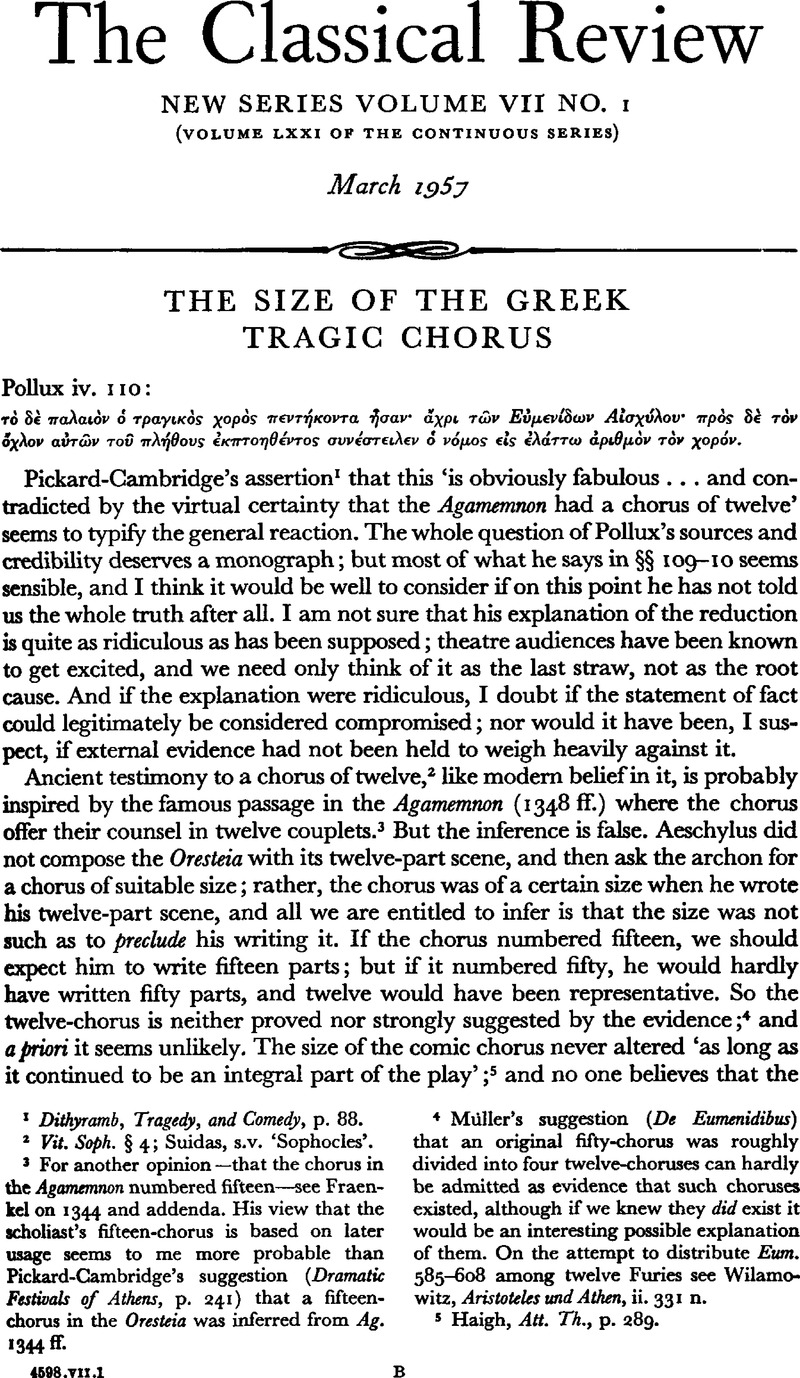No CrossRef data available.
Published online by Cambridge University Press: 13 February 2009

page 1 note 1 Dithyramb, Tragedy, and Comedy, p. 88.
page 1 note 2 Vit. Soph. § 4; Suidas, s.v. ‘Sophocles’.
page 1 note 3 For another opinion—that the chorus in the Agamemnon numbered fifteen—see Fraenkel on 1344 and addenda. His view that the scholiast's fifteen-chorus is based on later usage seems to me more probable than Pickard-Cambridge's suggestion (Dramatic Festivals of Athens, p. 241) that a fifteen-chorus in the Oresteia was inferred from Ag. 344 ff.
page 1 note 4 Muller's suggestion (De Eumenidibus) that an original fifty-chorus was roughly divided into four twelve-choruses can hardly be admitted as evidence that such choruses existed, although if we knew they did exist it would be an interesting possible explanation of them. On the attempt to distribute Eum. 585–608 among twelve Furies see Wilamowitz, Aristoteles und Athen, ii. 331 n.
page 1 note 5 Haigh, Att. Th., p. 289.
page 2 note 1 Pickard-Cambridge, Theatre of Dionysus in Athens, p. 32. Antiphanes (fr. 204. 5) says a man may beggar himself to provide golden cloaks for his chorus. Apparel may well have been richer then, but numbers smaller.
page 2 note 2 e.g.Jebb on Aj. 866. Ph. 827; Flickinger, Greek Theater and its Drama, p. 134. Why should sub-leaders have tobe added, rather than created within the existing chorus?
page 2 note 3 Though, as the advocates of the twelve-chorus believe that it lasted a long time, per-haps from the first, we may be permitted to ask why the assumed improvement took so long to discover.
page 2 note 4 For the groups, see Rose, Handbook of Greek Mythology, p. 41; he refers to Roscher, Die Zahl 50 in Mythus. Plays which had, or may be thought to have had, such groups for argutheir choruses are: Phrynichus—Αἰγύπτιοι Δαναἰδες; Aeschylus—![]() (Argonauts),
(Argonauts), ![]() (Nereids, v. Σ Ar.. Ach. 883; Ox. Pap. 2256, 71 is not from this play, for Ajax cannot be the first as well as the second term of comparison), Ὀστολόγοι (suitors' relatives), Πηνελόπη (suitors), Ψυχαγωγοί (Odysseus' crew).
(Nereids, v. Σ Ar.. Ach. 883; Ox. Pap. 2256, 71 is not from this play, for Ajax cannot be the first as well as the second term of comparison), Ὀστολόγοι (suitors' relatives), Πηνελόπη (suitors), Ψυχαγωγοί (Odysseus' crew).
page 2 note 5 321, v. Pickard-Cambridge, Dith., p.88; Theatre, p. 32. On this point I find my judgement curiously at variance with Pickard-Cambridge. He thinks his position would have been weaker if the Suppliants had spoken of themselves as fifty; I think it would have been stronger. If twelve people look me in the eye, and tell me they are fifty, I just have to accept it. It is the oblique reference which seems to me to require visual aid.
page 2 note 6 Pickard-Cambridge, Dith., p. 88, and (less confidently) Theatre, p. 31. The argument is vitiated by the assumption that Wilamowitz's conception of the staging of the Supplices is necessaryto the view that the Chorus numbered fifty.
page 3 note 1 In a similar situation (Eur. Hcld. 274) the herald departs remarking ![]() .
.
page 3 note 2 Davison, C.R. lxvii. 144; Yorke, C.R. lxviii. 10; Turner, C.R. lxviii. 21; Webster, Anzeiger für die Altertumswissenschaft, viii. 3. 158. Mr. Yorke's statistical method (C.Q., xxx. 116) has been so splendidly vindicated that we cannot blame him for wanting to set the Supplices before the Septem. It is hard to say what conscious or subconscious factors produce metrical tightening; but it seems just possible that Aeschylus in the Septem, while allowing himself 17 resolutions in proper names, would tighten up elsewhere in compensation. If I count in the proper names—which is carrying my suggestion too far—I get resolution figures of 1 in 7½ (Persae), 8½ (Septem), 10⅓ (Supplices).
page 3 note 3 Bonner and Smith, Administration of Justice from Homer to Aristotle, i. ch. 4. Wilamowitz's view (Aristoteles und Athen, ii, ch. 7) that the procedure of the Aeschylean Areopagus belongs to the Heliaea, and its reverence to the Furies, makes interesting reading but its evidential basis is slight.
page 3 note 4 Dith., p. 88; Oxford Classical Dictionary, s.v. ‘Tragedy’, § 2.
page 4 note 1 In forming my view of these matters, I have had the advantage of discussion with Mr. D. W. Lucas.